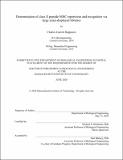Determination of class II peptide-MHC repertoires and recognition via large yeast-displayed libraries
Author(s)
Rappazzo, Charles Garrett.
Download1197071798-MIT.pdf (5.437Mb)
Other Contributors
Massachusetts Institute of Technology. Department of Biological Engineering.
Advisor
Michael E. Birnbaum.
Terms of use
Metadata
Show full item recordAbstract
T cells occupy essential roles throughout the immune system to prevent and limit disease. As such, breakdowns in their function and recognition underlie poor clinical outcomes across diverse maladies including pathogen infection, cancer, autoimmunity, allergies, and transplant rejection. Yet, when properly directed, T cells drive potent protective and therapeutic responses in prophylactic vaccinations and novel immunotherapies. Therefore, understanding and harnessing T cell function and recognition is of great importance to improving patient care and addressing currently unmet clinical needs. The function and recognition of T cells are driven through their T cell receptors (TCRs), which bind with great specificity to peptide-MHCs (pMHCs), Major Histocompatibility Complex proteins displaying tissue- and disease-specific peptide antigens derived from their host cell or its surroundings. However, to specifically and comprehensively present and surveil antigens across highly divergent maladies, extreme diversity is required of both the population-level TCR and pMHC repertoires. However, this same diversity which drives T cell function also confounds generalized understanding of these repertoires, as well as their recognition. Therefore, there has been considerable recent interest in the development and application of tools to comprehensively define, predict, and screen these repertoires and their recognition at high throughput. In this thesis, I both utilize and build upon these tools to define TCR and pMHC repertoires and explore their recognition, particularly with yeast-displayed pMHC libraries for CD4⁺ T cell recognition of class II pMHCs, and especially in the context of cancer. Using these technologies, I empirically define pMHC repertoires, explore the antigenic basis of TCR repertoire convergence in a preclinical tumor model, and explore the antigen reactivity of human T cells with clinical relevance. While these results provide detailed insights into the specific TCRs and pMHCs studied, they also provide guidance for future avenues in the exploration of TCR and pMHC repertoires and their recognition.
Description
Thesis: Ph. D., Massachusetts Institute of Technology, Department of Biological Engineering, May, 2020 Cataloged from PDF version of thesis. Includes bibliographical references.
Date issued
2020Department
Massachusetts Institute of Technology. Department of Biological EngineeringPublisher
Massachusetts Institute of Technology
Keywords
Biological Engineering.